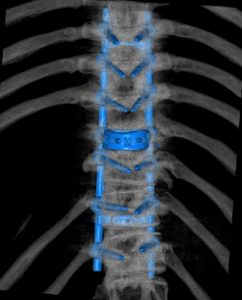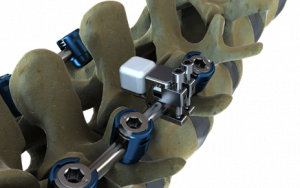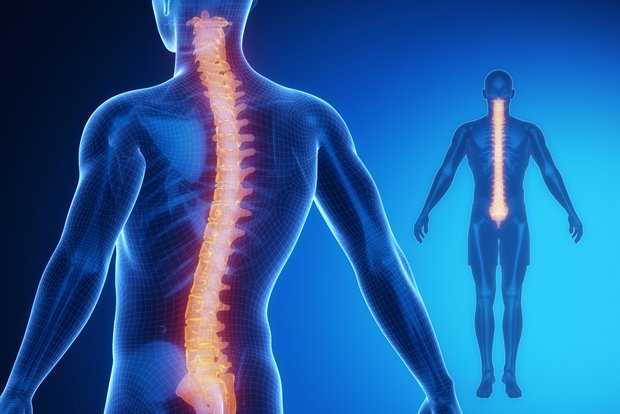A team of Australian researchers recently published a paper on a case involving a 72-year-old woman with sciatica and a complex L5–S1 pseudoarthrosis 12 months after L2–S1 fixation surgery for symptomatic degenerative scoliosis. The woman needed surgery to fix the complications she had developed, and the surgical team treated her using 3D printing from the beginning to the end of the procedure. You can access the paper, entitled “Designing patient-specific solutions using biomodelling and 3D-printing for revision lumbar spine surgery,” here.
CT data from patient scans was used to develop models of the bony lumbosacral spine for pre-operative planning, patient education, and reference during the procedure itself. The surgeon also worked with engineers to develop a patient-specific 3D printed titanium lumbrosacral fixation implant. 3D printing was also used to create a stereotactic drill guide.
At the patient’s six-month follow-up visit, the patient showed full resolution of symptoms, and radiography showed no evidence of implant dysfunction. These results mirror those of many other patients whose surgeries have been augmented by 3D printing, which is a sharp contrast to surgeries in which one-size-fits-all implants cause further pain and complications. The use of 3D printing enables surgeons to fix issues permanently, rather than requiring patients to come back a few years later for revisions, as is so often the case with many spinal surgeries.“Self-docking 3D-printed nylon tubular retractors specific to patient tissue depth and bony anatomy at L5–S1 were developed for a minimally invasive transforaminal approach,” the researchers add. “The pre-selected screws were separately sourced, bundled with the patient-specific devices, and supplied as a kit to the hospital before surgery.”
The use of 3D printing in spinal surgeries has not only saved people from further discomfort and revision surgeries but has actually saved lives – titanium implants have restored vertebrae and prevented paralysis and even death on more than one occasion. A catastrophic spinal condition, with the loss of vertebrae, sentenced people to a lifetime of disability not long ago, but 3D printing is allowing these people to walk again. The importance of the technology’s ability to create patient-specific implants cannot be overstated; surgeons can now effectively replicate parts of the human body.
We may not yet be able to 3D print transplantable human organs, but 3D printing has still come an incredibly long way in medicine, and spinal surgeries and implants are an excellent example of how technology can restore the body. In time, it’s possible that paralysis may become a rarity, even with severe spinal injuries and conditions. If parts of the spine can be replaced by implants, will we eventually be able to replace the entire spine, or close to it? The possibilities are exciting, but in the meantime, people with less severe spinal conditions are living their lives in much less pain thanks to 3D printing.
Authors of the paper include Ganesha K. Thayaparan, Mark G. Owbridge, Robert G. Thompson, and Paul S. D’Urso.
Discuss this and other 3D printing topics at 3DPrintBoard.com or share your thoughts below.
Subscribe to Our Email Newsletter
Stay up-to-date on all the latest news from the 3D printing industry and receive information and offers from third party vendors.
You May Also Like
3D Printing News Briefs, April 13, 2024: Robotics, Orthotics, & Hypersonics
In 3D Printing News Briefs today, we’re focusing first on robotics, as Carnegie Mellon University’s new Robotics Innovation Center will house several community outreach programs, and Ugogo3D is now working...
Rail Giant Alstom Saves $15M with 3D Printing Automation Software 3D Spark
3D Spark has entered into a three-year deal with the rail giant Alstom. Alstom, a transport behemoth with annual revenues of $16 billion, specializes in the manufacture of trains, trams,...
Meltio Expands Global Reach with New Partnerships in the Americas and Europe
Spanish 3D printing manufacturer Meltio has expanded its sales network across the globe. With the addition of three new partners in the United States, Brazil, Argentina, and Italy, Meltio aims...
3D Printing Webinar and Event Roundup: April 7, 2024
Webinars and events in the 3D printing industry are picking back up this week! Sea-Air-Space is coming to Maryland, and SAE International is sponsoring a 3D Systems webinar about 3D...


































